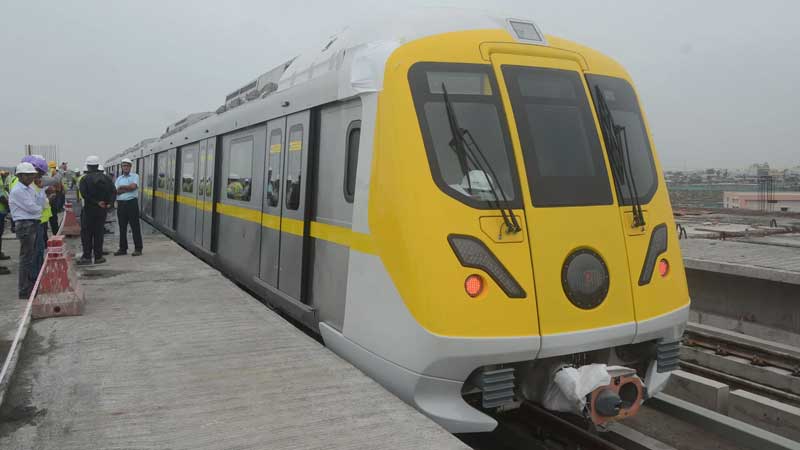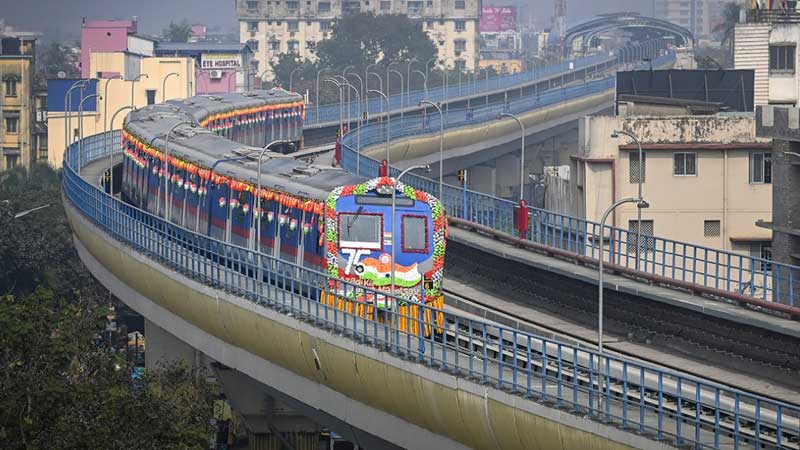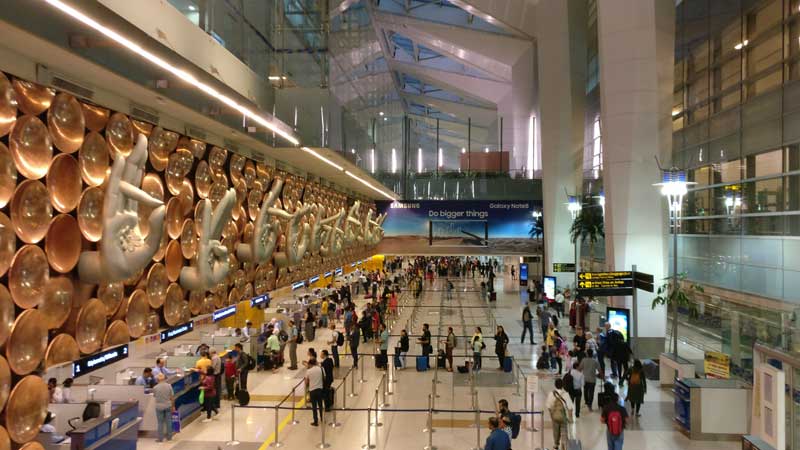Biggest Railway Station in India
In India, railway stations are busy places, with people constantly coming and going. Indian railway stations are no exception. Trains stop at railway stations to load and unload passengers and cargo. There is a lot of activity and life at the Indian Railway Station. Indian Railways is the nation's transportation lifeline and is the world's fourth-largest railway station network.
Thousands of passengers travel by train every year. The government has built new platforms that are larger and longer as a result of the increasing use of the Indian railways. In the past few decades, they have become an indispensable part of Indian life, helping millions to travel to work, visit family, and take vacations. India's economic infrastructure relies on it for connecting people and businesses across the country. The railway industry has been focusing on enhancing safety and efficiency by introducing new technologies in recent years. Improvements have been made to the railway network through a variety of initiatives.
| Name | No. of Platforms | No. of Tracks | No. of Daily Trains | City | State |
| Howrah Junction Railway Station (HWH) | 23 | 23 | 286 | Howrah | West Bengal |
| Sealdah Railway Station (SDAH) | 21 | 28 | 78 | Kolkata | West Bengal |
| Chhatrapati Shivaji Terminus (CSTM) | 18 | 40(Multiple) | 130 | Mumbai | Maharashtra |
| Chennai Central Railway Station (MAS) | 17 | 30 | 170 | Chennai | Tamilnadu |
| New Delhi Railway Station (NDLS) | 16 | 18 | 342 | New Delhi | Delhi |
| Ahmedabad Junction Railway Station (ADI) | 12 | 16 | 340 | Ahmedabad | Gujarat |
| Kharagpur Junction Railway Station (KGP) | 12 | 24 | 265 | Kharagpur | West Bengal |
The history and architecture of the biggest railway station in India are unique, making them all worthwhile stops. Approximately 12,000 railway stations are located in the Indian railway system.
India has the largest railway stations due to various factors. Some of them are based on size, others are based on population. A number of factors contribute to India's designation as the largest railway station such as architecture and design heights and sizes of platforms Length of platforms Junctions or emerging railway routes.
Now that we are in 2023, the Indian railways have made great strides. New trains are now available with more amenities and features.
History of Indian Railways
A long history of railways has existed in India since the colonial period. Today, India's railway system is one of the most complex and largest railways in the world. Almost 23 million people use Indian railways and 2.8 million tons of freight is transported each day. In times of war, the railways carried troops and supplies, and during times of peace, they made it easier for people and goods to move.
The East India Company first proposed building a railway network in British India. In 1832, India's first railway proposal was made in Madras. The Red Hill Railway was the country's first transport train. During the 1836-1837 period, it ran from Red Hills to the Chintadripet bridge in Madras. On 16 April 1853, The train ran 34 kilometres (21 mi) between Bori Bunder (Mumbai) and Thane by 400 people in 14 carriages travelled with a broad gauge of 1,676 millimetres, it was the first passenger train operated by the Great Indian Peninsula Railway in India. The first passenger train was operated in Eastern India between Howrah, near Kolkata, and Hoogly on 15 August 1854 and on 1 July 1856 first passenger train in South India was operated between the station Royapuram-Vyasarpadi (Madras) to Walajah Road (Arcot).
New Delhi introduced computerised ticketing and reservations in 1986, Indian Railways announced in March 2017 that the country's entire rail network would be electrified by 2022 or 2023 and become net-zero or carbon emission by 2030.
There have been many changes in the Indian Railways since its beginnings. In 1951, it was nationalised in order to bring all the different railway systems together as one (Government of India).
Different types of railway stations are located in India, One of the most common types of railway stations in India is suburban stations, which are often located near cities. Suburban railway stations have their own unique features. Stations like these usually have fewer platforms than other types of stations in India, whereas long-distance stations are used for trains that travel between states. A small railway station with only a few platforms is another type of railway station in India.
In terms of network size, Indian Railways ranks fourth with 1.2 lakh kilometres. Trains operated by the Indian Railways are mainly classified into three categories: express trains, mail trains, and passenger trains. Additionally, trains frequently run at capacity on this busiest railway network.
The biggest railway stations in India are likely to remain so for a long time to come. They are a significant part of India's history.
Longest Railway Station in India
The longest and most platform-filled railway stations in India are Listed below (the longest railway stations in India ). Difficult to mention the name of a railway station that is bigger than only in terms of platform or length of the track or the no of trains.:-
- Howrah Junction Railway Station
- Sealdah Railway Station
- Chhatrapati Shivaji Terminus, Mumbai
- New Delhi Railway Station
- Chennai Central Railway Station
- Kanpur Central Station
- Allahabad Junction
- Patna Junction
- Ahmedabad Junction
- Vijayawada Junction
- Bangalore City Railway Station
- Lucknow Charbagh Railway Station
- Varanasi Junction
- Mughalsarai Junction
- Kalyan Junction
The following biggest railway stations in India ranked on top based on different factors:
Howrah Junction Railway Station
A railway station in Howrah is the busiest and largest railway station in India. It is the headquarters of the Eastern Railway zone of Indian Railways. It is situated on the west bank of the Hooghly River In the state of West Bengal.

In 1854, Howrah railway station was opened to the public as Calcutta Station. It was renamed in 1955. First trains leaving Howrah to New Delhi, such as the Rajdhani Express On 3 October 1969, Double Decker in October 2011, and Antyodaya Express on 2 February 2017, respectively.
Around 1,600 trains pass through the station every day, as well as a large number(approximately 2 lakh passengers) of passengers. Out of 23 platforms, 16 are dedicated to long-distance trains, while seven are for suburban trains. The Kolkata suburban train has its own platform. Additionally, it is one of the busiest freight terminals in the country.
As passengers and trains have increased, the station has been expanded and modernised several times over the years. There are five intercity railway stations in Kolkata metropolitan area (including Howrah, Kolkata Chitpur, Sealdah, Santragachi, Shalimar and Sealdah). Howrah Railway Station has direct connections with 1373 stations across the country and, 286 trains cross the station daily. There are food stalls, washrooms, waiting rooms, booking counters etc. at the largest Junction platform (Howrah Junction) in India for passengers.
| No of platform | No of Track | No of trains Runs daily |
| 23 | 23 | 286 |
List of Howrah Junction's most important trains
- Howrah-New Delhi Rajdhani Express 02305 travels by Patna;
- Howrah-New Delhi Rajdhani Express 02301 travels by Gaya;
- Howrah-Puri Shatabdi Express (02277 )
- Howrah-Patna Jan Shatabdi Express 02023
- Howrah-Pune AC Duronto Express 02222
- Howrah-New Delhi Duronto Express 02273
- Kumbh Express 02369
- AC Duronto Express 02262 runs between Howrah and Mumbai
- Howrah-Yesvantpur Duronto Express 02245
Sealdah Railway Station
Sealdah is one of the major suburban stations of Kolkata. This station was opened around 158 years ago and was established around the mid-19th century. Sealdah railway station is also the most important and biggest railway station in India, which consists of mainly two terminals, the north and the south terminal. In total, there are 3 terminals: Sealdah North, Sealdah Main, and Sealdah South. There are 14 platforms in the north terminal of Sealdah station, and 7 platforms in the south terminal, serving approximately 1.8 million commuters daily.

It is India's second largest railway station, It holds 28 tracks and 21 platforms with 78 trains crossing each day. It is the destination of 320 passenger trains a day, and it also originates 39 trains. The executive lounge is also there at Sealdah, where passengers can relax before boarding the next train and take a shower, eat and drink for a while.
| No of platform | No of Track | No. of trains run daily |
| 21 | 28 | 78 |
List of Sealdah Junction's most important trains
- Ajmer-Sealdah Superfast Express( 02987 )
- Sealdah-New Delhi Rajdhani Express(02313) is available
- Jalianwala Bagh Express(02379 ) is also available.
- Sampark Kranti Express(02329)
Chhatrapati Shivaji Terminus, Mumbai
Chhatrapati Shivaji Maharaj Terminus is the biggest railway station in terms of size and height. It is the largest railway station in terms of architectural design. According to Frederick William Stevens' design, the station is inspired by the Victorian Italianate Gothic Revival architectural style. Building of the station began in 1878 and In 1887, Queen Victoria's rule celebrated 50 years when the station was completed, located south of the old Bori Bunder railway station. Originally known as Victoria Terminus, It was renamed "Chhatrapati Shivaji Maharaj Terminus" in 2017 after being renamed "Victoria Terminus" in March 1996. It has 18 platforms and 40 multiple rail tracks and 130 passenger trains cross the station every day. Among these 18, 11 operate long-distance trains from Mumbai, while 7 operate local trains.

UNESCO has listed the Chhatrapati Shivaji Maharaj Terminus as a World Heritage Site. It looks like a palace from the outside. It runs intrastate and intercity trains as well as Mumbai local trains, which makes it the best and longest railway station in India.
| No of Platform | No of Track | No of train runs daily |
| 18 | 40 (Multiple) | 130 |
List of Chhatrapati Shivaji Maharaj Terminus Junction's most important train
- Latur Cstm Express (12528)
- Cstm Latur Express (12527)
- Indrayani Express (22106)
- Cstm Garibrath (02187)
- Jbp Garib Rath S (02188)
- Pune Nzm Special (01077)
- Bsb Cstm Special (01080)
- Bbs Cstm Special (01020)
Chennai Central Railway Station
In Tamil Nadu, the Chennai Central railway station is regarded as one of the cleanest and biggest railway stations in India. This vintage railway station is located in Chennai Central. It connects Kolkata, New Delhi, and Mumbai to the northern part of the country. Around 550,000 people use the station every day, making it one of the busiest railway stations in India. Formerly known as Madras Central, it is the largest railway station in South India. The station code for Chennai Central is MAS.

This landmark building was designed by George Harding and renamed twice. Madras Central was renamed to Chennai Central in 1996 when the city was changed from Madras to Chennai. Then, From 5 April 2019, it will be known as Puratchi Thalaivar Dr M.G. Ramachandran Central Railway Station. The station has 17 platforms. 12 are for long-distance trains and 5 are for local and suburban trains. Around 170 trains run at the Chennai Central railway station. Restaurants, internet access, CCTV camera, accommodations, a waiting hall, a shopping mall, and more are available at Chennai Central Railway Station.
| No of platform | No of Track | No. of trains run daily |
| 17 | 30 | 170 |
List of Chennai Central railway Junction's most important train
- Gomti Sagar Express (06093)
- MGR Chennai Central-Hazrat Nizamuddin Garib Rath Express (02611)
- MGR Chennai Central-Mysuru Shatabdi Special (06081)
- Andaman Express (06031 )
- MGR Chennai Central-Hazrat Nizamuddin Rajdhani Express (02433 )
- MGR Chennai Central-Hazrat Nizamuddin Duronto Express (02269 )
New Delhi Railway Station
New Delhi Railway Station is Located between Paharganj and Ajmeri Gate, this is the main railway station of the city that remains crowded throughout the year. There is a high frequency of trains and a high number of passengers using the station, making it one of the largest railway stations in the country. NDLS (New Delhi Railway Station) was established in 1926. With 16 platforms and 18 tracks, New Delhi Railway Station is the fourth busiest railway station in the country and boasts one of the most complex interlocking systems. Around 342 trains and 270 passenger trains per day pass through its tracks, making it the most profitable railway station.

New Delhi Railway Station is also the origin and termination point of most trains travelling east and south. In addition to being the main hub for most of the Rajdhani Express trains. Additionally, New Delhi Railway Station is connected to the Delhi Metro service. Despite handling around half a million(approximately 500,000) people a day, the station remains one of the biggest railway junctions in India.
| No of platform | No of Track | No of train runs daily |
| 16 | 18 | 342 |
List of Chennai Central railway Junction's most important train
- New Delhi-Sealdah Rajdhani Express(02314 )
- New Delhi-Dibrugarh Town Rajdhani Express(02424 )
- New Delhi-Ranchi Rajdhani Express Via Daltonganj (02454 )
- New Delhi-Bilaspur Rajdhani Express(02442 )
- New Delhi-Dibrugarh Rajdhani Express Via Barauni(20506 )
- New Delhi-Ranchi Rajdhani Express Via Bokaro Steel City(20840 )
Conclusion
These were some of the biggest railway stations in India, So it can be truly said that Indian Railways are the heartbeat or can say lifeline of the nation and are an extremely important part of all Indians, they rely on it for a significant mode of transportation each day!
Common Questions about Biggest Railway Station in India
What are the facilities available at all the railway stations for passengers?
All of the biggest railway stations in India have special areas for senior citizens, disabled people, and pregnant women including a range of services and facilities for passengers, such as ticketing services, bathrooms, refreshment stalls, waiting rooms, ATMs and Wi-Fi access.
How many platforms does the biggest railway station in India have?
The biggest railway station in India is the Howrah Junction with 23 platforms, out of which 18 are active and 5 are used for operations.
Which is the longest railway station in India?
In India, Howrah Junction has the world's longest station platform at 1,505 metres (4,938 ft).
Where Is India's busiest railway station?
Howrah Junction Railway Station, located in Howrah, West Bengal, India is the busiest railway station in India.















